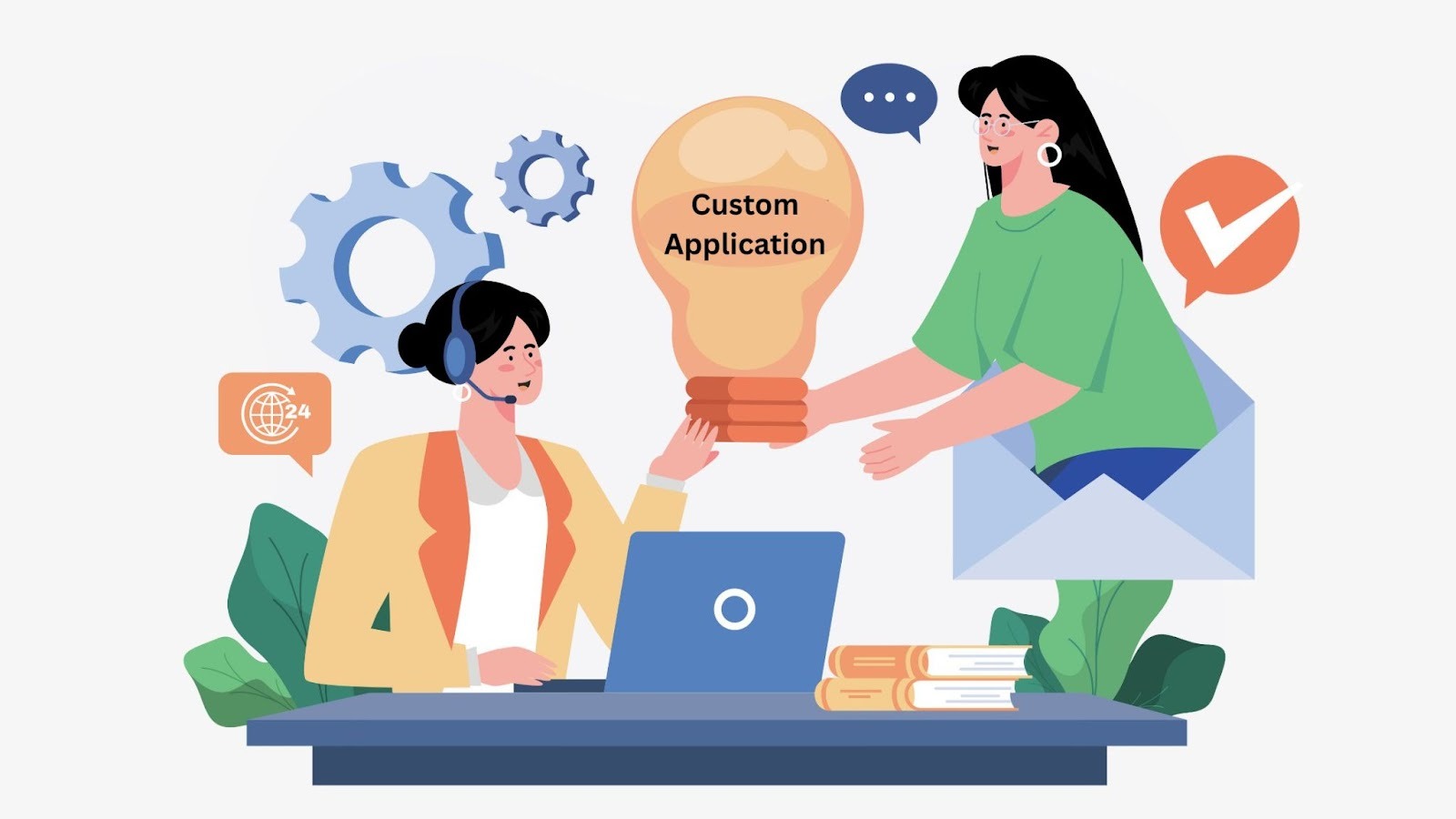How to Build a Custom Application from Scratch?

Building a custom application from scratch is a complex yet rewarding process that allows you to create tailored solutions for specific business or personal needs. Whether you’re developing a web app, mobile app, or desktop software, this journey involves careful planning, strategic design, and precise execution.
In this guide, we’ll walk you through each step of the process—from idea validation and selecting the right tech stack to design, development, testing, and deployment. Whether you’re a startup founder, product manager, or a custom app development company, this roadmap will help turn your vision into a scalable, user-friendly application.
What is a Custom Application?
A custom application is a software solution specifically designed and developed to meet the unique needs and requirements of a business or individual. Unlike off-the-shelf applications, custom apps are tailored to address specific workflows, functionalities, and goals. They can be built for various platforms, such as mobile or web, ensuring a seamless user experience. Custom applications offer greater flexibility, scalability, and integration options, allowing businesses to enhance efficiency, improve productivity, and deliver unique services to their users.
How Does a Custom Application Work?
A custom application works by addressing specific business needs through personalized features and functionality. First, businesses identify their goals and requirements, which guide the design and development process. Developers then create a solution tailored to these needs, ensuring the app integrates seamlessly with existing systems and workflows.
Custom applications are built with scalability in mind, allowing for future updates and expansions. They are often developed using programming languages and frameworks suitable for the business’s platform, whether web, mobile, or desktop. Once deployed, the application undergoes continuous maintenance and updates to keep it optimized and aligned with changing business demands.
Step-by-Step to Build a Custom Application from Scratch
Building a custom application from scratch involves several key steps to ensure it meets the specific needs of your business. Here’s a step-by-step guide:
Step 1: Define the Purpose and Goals
Defining the purpose and goals of your custom application is the foundation of the entire development process. This step involves understanding what problem the app will solve, who the target audience is, and how the app will deliver value to both the business and its users. Here’s how to approach this step:
Clarify the Problem You Are Solving
The first step in building a custom application is defining its purpose. What problem does your app solve? How does it meet the needs of its target audience? Before jumping into technicalities, take a step back and clarify the real-world problem your app addresses. This will guide your development process.
Set Clear Goals
Once you know the problem, outline the goals your app should achieve. These might include increasing efficiency, reducing costs, or improving customer experience. Knowing exactly what your app aims to accomplish will keep the project on track and help you measure its success later.
Step 2: Plan the Features and Functionality
When planning the features and functionality of a product or project, it’s essential to outline what the end product should accomplish and how it will interact with users. This step provides a roadmap for development and ensures all stakeholders are aligned on the vision. Here’s a guide for planning the features and functionality:
Prioritize Features
Now that you know the purpose and goals of the app, it’s time to figure out which features to include. This is where you turn the big idea into concrete actions. Start by listing all the features that would benefit your users, then prioritize them. Focus on delivering the most important features first.
Essential Features:
- User registration and authentication
- Dashboards or main interfaces
- Data storage and management
- Communication features (like notifications or chats)
Outline User Stories
User stories help you frame the app’s functionality from the perspective of the end user. For example, a user story might be: “As a user, I want to log in using my Google account, so I don’t have to remember another password.” These stories guide the development process, ensuring that the app delivers value at each step.
Step 3: Choose the Technology Stack
Choosing the right technology stack is a crucial step in any project, as it determines the tools, frameworks, and technologies you’ll use for development. The stack you select will affect the performance, scalability, and maintainability of the system.
Frontend Development
The frontend is the part of the app that users interact with. It’s the user interface (UI) and user experience (UX) that make the app easy to use. Common frontend technologies include:
- HTML/CSS/JavaScript: Basic building blocks of any web application.
- React.js: A popular JavaScript library for building user interfaces.
- Vue.js: A progressive framework for building user interfaces.
Choose the frontend framework that best suits your team’s skills and the needs of your app.
Backend Development
The backend handles the behind-the-scenes tasks, like data management, user authentication, and business logic. For backend development, you can use:
- Node.js: A JavaScript runtime environment for building scalable backend applications.
- Ruby on Rails: A framework for web development that uses the Ruby language.
- Django: A Python-based framework for rapid development of secure applications.
Consider the complexity of your app and your team’s expertise when picking your backend technology.
Database Selection
Your app will need a database to store user data, application information, and other crucial data. Popular database choices include:
- MySQL: A relational database system known for reliability.
- PostgreSQL: A powerful, open-source relational database.
- MongoDB: A NoSQL database for handling unstructured data.
The type of database you choose should depend on your app’s data structure and scalability needs.
Cloud or On-Premises Hosting
Where will your application be hosted? Most modern apps are hosted in the cloud, making it easier to scale and manage. Popular cloud providers include:
- Amazon Web Services (AWS)
- Google Cloud Platform (GCP)
- Microsoft Azure
For on-premises hosting, you’ll need to invest in server hardware and manage the infrastructure yourself.
Step 4: Design the Application
Designing your application is a crucial phase where you map out how it will look, function, and interact with users and other systems. This process involves both user experience (UX) design and user interface (UI) design, as well as architectural design. Let’s break this down into several key areas:
Build Wireframes
Wireframes are the basic visual representation of your app’s interface. They help you plan the layout and navigation structure before committing to a full design. Wireframing tools like Figma or Sketch let you map out the user interface (UI) and user experience (UX).
Develop User Interface Design
Once you have wireframes, it’s time to create the actual design. This is the stage where you choose colors, fonts, icons, and other elements that create an appealing user interface. Ensure the design is intuitive and user-friendly, keeping in mind accessibility features like contrast and readability.
Focus on UX
The user experience (UX) of your app is critical. Good UX ensures that users can navigate your app with ease and that the app performs tasks efficiently. From loading times to interactive elements, everything should work smoothly. Test the design with real users, gather feedback, and iterate on the design to make it better.
Step 5: Develop the Application
Developing the application involves the actual coding and implementation of the planned features. This step is where your design comes to life. Whether you’re working with an in-house team or hire mobile app developers, it’s essential to follow a structured approach. Here’s a general outline of the process you can follow to develop an application:
Set Up the Development Environment
Before starting actual coding, make sure your development environment is set up correctly. This includes installing necessary tools, libraries, and frameworks. Version control systems like Git are essential to manage code changes and collaborate with team members.
Start with Core Functionality
Begin development with the core features that are crucial for the app’s functionality. This might include setting up user authentication, integrating the database, and building key workflows.
Develop and Integrate Features
Work on adding more features in sprints or phases. For example, if you’re building an e-commerce app, you’ll need to add:
- Shopping cart functionality
- Payment gateway integration
- User profiles
After coding each feature, perform unit testing to ensure each one functions as expected.
Step 6: Test the Application
Testing the application is a crucial step in the software development process. It ensures that everything is working as expected and that the application is free from bugs or unexpected behavior. Here’s a general breakdown of Step 6: Test the Application for a typical software project:
Types of Testing
Testing is a critical phase that can’t be skipped. It ensures your app works as expected and eliminates bugs that might disrupt user experience. There are different types of testing to focus on:
- Unit Testing: Test individual pieces of code.
- Integration Testing: Ensure different parts of the application work together.
- User Acceptance Testing (UAT): Have real users test the app and provide feedback.
- Performance Testing: Check if your app performs well under heavy traffic or usage.
Bug Fixing
Once the tests are done, gather feedback, and fix any bugs or issues. This may involve refactoring parts of the code to improve performance or functionality.
Step 7: Deploy the Application
Deploying an application involves getting your app live and accessible for users. Below are the general steps for deploying a web application. The exact process may vary depending on your stack (e.g., front-end framework, back-end language, database, and hosting provider). I’ll give you an overview of how to deploy an application, focusing mainly on web applications:
Prepare for Deployment
Once the app is tested and free of major bugs, it’s time to deploy it. Set up your hosting environment, ensure your database is secure, and configure domain names, email servers, and other backend systems.
If you’re deploying a web application, you may need to choose between options like Heroku, AWS, or DigitalOcean for hosting. For mobile apps, publish your app to platforms like Google Play or Apple’s App Store.
Monitor and Maintain
Deployment doesn’t mean your work is over. After your app is live, monitor its performance, track user interactions, and check for any issues. Provide regular updates, fix bugs, and add features based on user feedback.
Step 8: Marketing and User Acquisition
Marketing and user acquisition are critical to the success of any product or service, especially in the early stages. The goal of this phase is to create awareness, attract users, and convert them into loyal customers. Below are key strategies you can use to achieve this:
Build a Marketing Plan
As soon as your app is ready, start working on a marketing plan. Build awareness through content marketing, social media, and email campaigns. Create a website or landing page to showcase the app’s features and benefits.
Engage Users
Engagement is key to success. Encourage users to download, register, and use your app regularly. Create incentives for early adopters, such as discounts, free trials, or exclusive features.
Conclusion
Building a custom application from scratch is a challenging but rewarding process. By following the steps outlined above, from defining the purpose to post-launch marketing, you can create an app that addresses real needs and provides value to users.
Stay focused on delivering a high-quality user experience, and don’t forget that the launch is just the beginning. Continue improving your app by listening to feedback and adding new features that will keep users engaged.
With patience, persistence, and careful planning, your custom app can become a valuable tool that drives success and growth.














